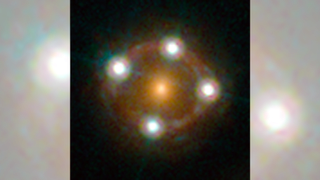Description

Disclaimer: Copyright infringement not intended.
Context
- Astronomers have made a stunning discovery of a rare astronomical phenomenon known as the "Einstein cross," where light from a distant galaxy is split and magnified by a foreground elliptical galaxy.
- This remarkable event was first predicted by Albert Einstein in 1915 as a consequence of his theory of general relativity.
- In this fascinating cosmic display, a background galaxy, likely a quasar, located about 11 billion light-years away, has its light warped and quadruplicated by a massive elliptical galaxy situated approximately 6 billion light-years from Earth.
Details
Introduction
- The Einstein Cross, also known as Q2237+0305, is a fascinating astronomical phenomenon.
- The Einstein Cross was discovered in 1985 by a team of astronomers led by Dennis Walsh.
- It is located in the constellation Pegasus and has a redshift of z ≈ 1.7, making it one of the most distant known quasars.
- The phenomenon was named the "Einstein Cross" due to the cross-like pattern created by the four bright images of the quasar around the lensing galaxy.
The Gravitational Lensing Effect
- Einstein's theory of general relativity explains how massive objects can warp the fabric of space-time.
- Gravity, as described by Einstein, is not a force but rather a result of space-time curvature caused by matter and energy.
- When light passes through highly curved regions of space-time, such as those near massive galaxies, it bends and forms a halo.
Time Delay and Microlensing
- As light from the quasar traverses different paths around the lensing galaxy, each image arrives at Earth with a slight time delay relative to the others.
- This time delay allows astronomers to measure the size and mass distribution of the lensing galaxy, aiding in studying dark matter and galaxy evolution.
- Microlensing, caused by individual stars within the lensing galaxy, can further enhance or distort the brightness of the images over time, providing valuable information about the lens's structure.

The Einstein Cross Arrangement
- In the case of the newly discovered Einstein cross, the observer (Earth), the lensing galaxy (foreground elliptical), and the background quasar have aligned in a way that perfectly duplicates the quasar's light.
- This alignment results in four smudges of blue light arranged around the orange of the foreground galaxy, forming a beautiful Einstein ring.
Insights from Einstein Rings
- Astronomers have identified hundreds of Einstein rings, not only for their stunning visual appeal but also for their scientific significance.
- These rings magnify and bend the light they receive, allowing astronomers to reconstruct the original, pre-bent light forms and observe distant galaxies in greater detail.
Cosmic Scale and Gauging Mass
- The extent to which light bends depends on the gravitational field's strength of the object causing the bending.
- Einstein rings serve as a cosmic scale for gauging the masses of galaxies and black holes.
- The study of distant light warping around these rings enables scientists to observe objects that may otherwise remain hidden, such as black holes and distant exoplanets.
Discovery and Follow-up Analyses
- The lens responsible for the Einstein cross was discovered in 2021 by the Dark Energy Spectroscopic Instrument attached to the telescope at Kitt Peak National Observatory in Arizona.
- Follow-up analyses were conducted using the Multi-Unit Spectroscopic Explorer at the Very Large Telescope in Chile to confirm the discovery.

Conclusion
The Einstein Cross, with its quadrisected and magnified light, is an extraordinary testament to the power of Einstein's theory of general relativity. It not only offers a mesmerizing view of the cosmos but also presents valuable opportunities for astronomers to deepen their understanding of the universe, explore distant galaxies, and gauge the masses of cosmic objects. Through continued research and observations, scientists aim to unravel even more mysteries hidden within the cosmic lens of gravitational bending.
|
PRACTICE QUESTION
Q. Explain the significance of the Einstein Cross in astrophysics and how it relates to the concept of gravitational lensing predicted by Albert Einstein's theory of general relativity. (150 Words)
|
https://www.livescience.com/physics-mathematics/gravity/rare-einstein-cross-warps-light-from-one-of-the-universes-brightest-objects-in-this-stunning-image











